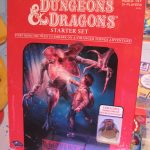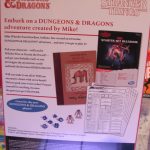Toy Fair 2019—Stranger Things Games
20 Feb
Posted by David Miller as Electronic Games, Modern Board Games, RPGs
 Presented by Hasbro at New York Toy Fair were three Stranger Things games coming to retail at the beginning of May.
Presented by Hasbro at New York Toy Fair were three Stranger Things games coming to retail at the beginning of May.
Stranger Things Back to the 80s Trivial Pursuit ($20) includes questions about the show and 1980s pop culture. It also features a board that flips to an alternative movement track representing the Upside Down. When a player’s piece lands on a portal, they’re all sent to the Upside Down, where it’s possible to lose a wedge.
A Stranger Things Dungeons & Dragons Starter Set ($25) includes essential rules, dice, two Demogorgon plastic figures (one painted, one not), an adventure book, and character sheets representing those played in the show.
The Stranger Things Palace Arcade console ($30) is a working miniaturized arcade-style video game system with 20 classic titles (such as Pac-Man and Galaga) and 16 more based on the show.
- Comments Off on Toy Fair 2019—Stranger Things Games
Power Rangers, D&D, and Other Highlights from Hasbro’s Investor Presentation at Toy Fair
20 Feb
Posted by David Miller as CCGs, Modern Board Games, RPGs
 After reporting in its recent financial results an 8 percent revenue growth for the overall gaming category in 2017, Hasbro on Friday said that Dungeons & Dragons sales were up 80 percent. That performance made 2017 the best year for D&D ever.
After reporting in its recent financial results an 8 percent revenue growth for the overall gaming category in 2017, Hasbro on Friday said that Dungeons & Dragons sales were up 80 percent. That performance made 2017 the best year for D&D ever.
A new agreement with Paramount will have Hasbro participating to a greater degree in funding its movie franchises but will also provide more reliable release dates. The Dungeons & Dragons movie is scheduled to hit theaters in 2021.
Star Wars revenue was down in 2017 but Hasbro remains positive about the license, saying the decrease represents a transition to more consistent sales, rather than surges tied to individual movie releases. One of the new Star Wars products that the company is planning for this year is a Furreal Friends Chewbaca.
Citing data from NPD, Hasbro claimed 13 of the top 20 face-to-face games in G10 markets, with Monopoly the number one overall games property.
Online retail accounts for 20 percent of the company’s toy and game sales.
Magic: The Gathering had the best year on record of new player growth.
Hasbro is launching HasLab to “put the power of innovation in the hands of fans.” Actually, HasLab is a crowdfunding platform for premium products not suitable for normal retail channels. The first campaign is for a toy model of Jabba the Hut’s sail barge in the scale of the company’s Star wars Vintage Collection. That makes it over 4 feet long! Five thousand backers at $500 each are required to go to production.
A new Dungeons & Dragons mobile game, Warriors of Waterdeep, is in development by Ludia.
Wizards of the Coast is working on other projects besides just Magic and D&D. The Hasbro subsidiary is developing a Transformers TCG and an Axis & Allies and Zombies board game.
Digital listening is driving development in Hasbro’s gaming category, whether games based on online trends or games designed for online sharing. The company has even put together a “quick strike team” for rapid development and speed to market with social listening.
Hasbro also has weather-targeted games marketing, running additional ads when its raining.
Hasbro sees location-based experiences as a key growth opportunity. This includes live shows, hotels, cruises, and family entertainment centers. Coming soon from Marriott are My Little Pony and Transformers hotels in Shanghai.
The company will launch on Earth Day a partnership with Terracycle to recycle toys and games.
WOTC will soon launch a Magic: The Gathering companion app called Portal, which in addition to a rules reference and life-tracker, will feature a matchmaker of sorts to connect players with new people for face-to-face home games. Netmarble is developing a mobile-to-mobile MtG app.
Hasbro has snagged the master toy license for Power Rangers. Products will begin arriving on shelves in 2019.
- Comments Off on Power Rangers, D&D, and Other Highlights from Hasbro’s Investor Presentation at Toy Fair
 Xanathar’s Guide to Everything from Wizards of the Coast is the first dedicated book of expansion rules for Dungeons & Dragons 5th edition. As a rule book it presents many game-enhancing options for players—character subclasses, spells, magic items—and tools for dungeon masters—trap design, encounter building, area-of-affect adjudication. Among the new subclasses (those path-of-specialization choices made by everyone somewhere between 1st and 3rd level) it’s the Bard College of Whispers, Samurai (Fighter), and Scout (Rogue) that most attract me. However, every one provides a unique path for players to explore, some magical, some martial, some mystical.
Xanathar’s Guide to Everything from Wizards of the Coast is the first dedicated book of expansion rules for Dungeons & Dragons 5th edition. As a rule book it presents many game-enhancing options for players—character subclasses, spells, magic items—and tools for dungeon masters—trap design, encounter building, area-of-affect adjudication. Among the new subclasses (those path-of-specialization choices made by everyone somewhere between 1st and 3rd level) it’s the Bard College of Whispers, Samurai (Fighter), and Scout (Rogue) that most attract me. However, every one provides a unique path for players to explore, some magical, some martial, some mystical.
The rules section, though, that I see most enhancing my game has to be the one on tool proficiencies. It provides some great ideas on how to use a piece of the game that in my experience is not well understood, and therefore mostly ignored. For example, it describes what use to make of a disguise kit, gaming set, and thieves’ tools. It also explains how to view a task that might benefit from both a skill proficiency and a tool proficiency, and what specific additional insights a character with both might realize.
But with all that, what really distinguishes Xanathar’s Guide is its focus on providing options to enhance the game’s story. That is, it’s more than just a book of mechanical rule options. Yes, you’ll find in it cool powers for your characters but more importantly, you’ll find in it ideas for cool backstories. The book has tables of suggestions for family history, rivals, mentors, personal keepsakes, life tragedies, and even a “weird stuff” list. Xanathar’s Guide also provides new feats specific to the various races and tables of character names by race and human-historical culture. As well, there’s a whole section on things that characters might do during their between-dungeon downtime, such as gambling, training, carousing, research, crafting, and more—and how a dungeon master might evaluate their success.
Now, I’m not going to say it does these things perfectly. The little sidebar notes from Xanathar, a well-known beholder out of the Forgotten Realms, I found just silly, though they’re small and easy to ignore. And the tables of random encounters, I thought were a wasted opportunity, pretty much listing groups of monsters, where there could have been more ideas for interesting locations, traveling groups, or even monsters with specific goals.
Nevertheless, Xanathar’s Guide to Everything is definitely one of the better and more inspiring RPG books I’ve encountered.
Xanathar’s Guide to Everything hit the shelves of local game stores today and can be found in general retail November 21st. The suggested retail price in $49.95.
A complimentary copy of Xanathar’s Guide to Everything was provided by Wizards of the Coast for review. Actually two, but we gave one away earlier this week.
- Comments Off on Second Look—Xanathar’s Guide to Everything
Xanathar’s Guide to Everything, the first major expansion to Dungeons & Dragons fifth edition, releases in game stores next Friday, November 10th, and to general retail November 21st. The book contains a variety of resources for both players and Dungeon Masters—among them new character class options, spells, and racial feats for players; magic items, encounter guidelines, and downtime activities for the DM.
Though I haven’t had an opportunity to study it in detail yet, Wizards of the Coast was kind enough to send me an advance copy. In fact, they sent me two! One is the standard edition, the other a beautiful alternative art cover (the one on the right) that will only be available through local game stores. But what do I need with two?
So while I’m reading through the book this weekend, leave a comment below with the name, race, and class of your favorite D&D character for a chance to win my extra book.
Leave your comment by Monday (November 6th) at noon Eastern Time. Sometime that afternoon, I’ll choose someone at random and contact them by email for a shipping address (U.S. only). Keep a watch out for the email. You’ll have 24 hours to respond before I choose someone else.
Good luck! You could have a copy of Xanathar’s Guide to Everything before it’s available in stores.
Update: The deadline has passed. Comments are closed. No more entries. I will select on contact the winner shortly.
Update: The winner was Grant and I’ve shipped out his book already. Thank you everyone for participating. I loved reading those character stories!
Boards to Bytes
11 Jul
Posted by David Miller as Card Games, Classic Board Games, Electronic Games, Modern Board Games
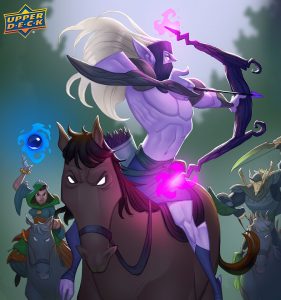 Upper Deck’s Legendary deck-building game is getting a digital version (iOS, Android, and Steam). Legendary DXP will feature a new fantasy setting, solo and match play, and a “gauntlet” mode for 5-player competitions and weekly leagues.
Upper Deck’s Legendary deck-building game is getting a digital version (iOS, Android, and Steam). Legendary DXP will feature a new fantasy setting, solo and match play, and a “gauntlet” mode for 5-player competitions and weekly leagues.
Magic: The Gathering is also due for a new digital version, this time in the form of a MMORPG from Cryptic Studios.
Codename Entertainment has licensed Dungeons & Dragons for a clicker game, Idle Champions of the Forgotten Realms. The game will take players on a quest through the Sword Coast region and will feature at launch two characters from the Force Grey streaming series. Updates and additional features, including a tie-in to the Tomb of Annihilation, are scheduled to occur monthly.
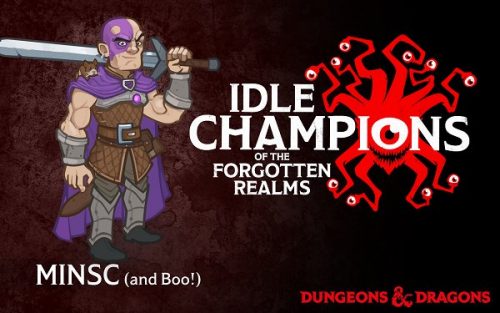
For the hard-core board gamer, the Board Game Stats app, useful for tracking one’s collection and logging games played, is now available on Android.
Ports of solitaire favorite Friday are now available on Android and iOS.
Race for the Galaxy, already available on Android and iOS, is now also good on PC via Steam ($7). It can be played against AI or cross-platform multiplayer. Both the Gathering Storm and Rebel vs Imperium expansions are available as add-ons at $4 each.
Asmodee Digital has launched Spot It! on mobile as Spot It! Duel: A Dobble Game (Android and iOS). In this digital form, as players progress through various arenas, they collect Dobble characters, who convey special powers. Spot It! Duel is free-to-play, with in-app purchases.
The Renegade Games Companion App has been upgraded with support for Clank! Sunken Treasures. And another game from Renegade has been announced by Dire Wolf Digital. Lotus, the game about assembling flowers from individual petals, is due on Android and iOS later this summer.
- Comments Off on Boards to Bytes
 Through June 3rd at The Bartell Theater in Madison, Wisconsin, Of Dice and Men is a play about a group of decidedly non-stereotypical Dungeons & Dragons players and lifelong friends.
Through June 3rd at The Bartell Theater in Madison, Wisconsin, Of Dice and Men is a play about a group of decidedly non-stereotypical Dungeons & Dragons players and lifelong friends.
Humor, brutal honesty and the good-natured kidding of people who know each other far too well culminate in an unforgettable evening that will make you laugh and think – and do so in a way that celebrates the power of gaming to bring people together, never once apologizing for it.
AdventureFight, which debuted this past Tuesday at JJ’s Bohemia in Chattanooga, is a live comedic roleplaying event with audience participation. The people rolling dice on-stage are actors but the game is unrehearsed. Also, audience members can volunteer to play various NPCs. Admission is $5 or free for those wearing medieval fantasy costumes.
Improvised Dungeons & Dragons shows are running in Edmonton, Atlanta, and Denver. This one has audience members rolling dice and challenging those on-stage to act their way through the adventure in-character.
- Comments Off on RPG Theater
 Releasing today is Rise of the Dungeon Master, a graphic novel about the life of Gary Gygax and development of Dungeons & Dragons. The book, written by David Kushner and illustrated by Koren Shadmi, is 144 pages and available in paperback or Kindle format.
Releasing today is Rise of the Dungeon Master, a graphic novel about the life of Gary Gygax and development of Dungeons & Dragons. The book, written by David Kushner and illustrated by Koren Shadmi, is 144 pages and available in paperback or Kindle format.
Like the game itself, the narrative casts the reader into the adventure from a first person point of view, taking on the roles of the different characters in the story.
- Comments Off on Rise of the Dungeon Master
Dragonfire—Dungeons & Dragons Deck-building Adventure Game From Catalyst
25 Apr
Posted by David Miller as Modern Board Games, RPGs
 Catalyst Game Labs announced today Dragonfire, a deck-building adventure game based on Dungeons & Dragons and set in the Forgotten Realms. The initial release, “coming soon”, will have players choosing from classic D&D races and classes and beginning their adventure along the Sword Coast. The company also plans future expansions with players leveling up their characters while visiting Baldur’s Gate, Neverwinter, and Waterdeep.
Catalyst Game Labs announced today Dragonfire, a deck-building adventure game based on Dungeons & Dragons and set in the Forgotten Realms. The initial release, “coming soon”, will have players choosing from classic D&D races and classes and beginning their adventure along the Sword Coast. The company also plans future expansions with players leveling up their characters while visiting Baldur’s Gate, Neverwinter, and Waterdeep.
Catalyst is building Dragonfire from the same system the company used for its Shadowrun: Crossfire game (though the two will definitely not be compatible).
Adapting that engine to Dungeons & Dragons is an exciting opportunity to build new ways for players to experience both quick adventures and long-term campaigns in this legendary high-fantasy setting. And at every step, Catalyst has worked hard to remain true to D&D lore. When players open a copy at the table, regardless of what they enjoy playing—RPGs, deckbuilder games, or both—they’ll find a complete box of fun.
Dragonfire will be priced at $60 retail and come with five decks of encounter cards, plus a market deck, magic item deck, character cards, adventure cards, an adventure book, sticker sheets, tokens, plastic clips, and a rule book.
Among the expansions planned are Wondrous Cache (more magic items), Heroes of the Sword Coast (more character cards with new classes and races), and Encounters: Dragonspear Castle (a new adventure with more encounter, magic item, and market cards). Several of the expansions are going to print at the same time as the base game.
- Comments Off on Dragonfire—Dungeons & Dragons Deck-building Adventure Game From Catalyst
 Tales from the Yawning Portal. I’m not sure what to make of this product, but let’s start.
Tales from the Yawning Portal. I’m not sure what to make of this product, but let’s start.
The book is a collection of classic Dungeons & Dragons adventures updated for Fifth Edition, arranged so one could just go through each in order with a group of characters, campaign-like. None of the adventures link to any other. This is a book of nostalgia, bringing adventure modules from the early days of Dungeons & Dragons to “D&D Next” up to speed with current rules.
 Aside from the nostalgia factor, I’m not certain why this book exists the way it does. Fifth Edition’s adventure offerings sold in stores have mainly been campaign-driven, from Tyranny of Dragons through Storm King’s Thunder. One-off adventures have been limited to the organized play program run at game stores. To me, it makes more sense to use a collection of those adventures to show 5e Dungeon Masters how to structure a 5e adventure.
Aside from the nostalgia factor, I’m not certain why this book exists the way it does. Fifth Edition’s adventure offerings sold in stores have mainly been campaign-driven, from Tyranny of Dragons through Storm King’s Thunder. One-off adventures have been limited to the organized play program run at game stores. To me, it makes more sense to use a collection of those adventures to show 5e Dungeon Masters how to structure a 5e adventure.
Take Tomb of Horrors, a classic adventure module. The design for this 1970s module doesn’t look like what design in the 2010s should be: the adventure is mainly linear and has a more adversarial DM versus player mindset than games in the past few decades have been. Despite this edition’s claim that Tomb of Horrors was supposed to be a “thinking person’s adventure”, TSR’s Lawrence Shick said the traps in the adventure were intended “not to challenge the intruders but to kill them dead.” (Wizards of the Coast from a few years back even wrote, “Gygax’s main purpose in creating Tomb of Horrors was to take his players down a peg.”)
The version I played, back when D&D was Advanced, involved several instances where you had to make saving throws or your character would die. Fifth Edition really goes out of its way to keep player characters from dying from a bad die roll or two, but in this update there are still plenty of insta-death: “…which is fatal, and all the characters in the … area are dead, with no saving throw, while any in the [nearby area] are slain unless they succeed on a DC 17 Constitution saving throw.” “Roll initiative. On initiative count 10, anyone still in [the area] is crushed against the roof and slain.”
But people love Tomb of Horrors. They want to play it. They’ve heard the stories. Can I survive the gauntlet, they wonder. Perhaps we all just make three or four level 18 heroes and see if we can get to the end. It’s part of D&D history, like Eric and the Gazebo or The Head of Vecna.
I feel that the form factor of the book hampers the re-envisioning of these classic adventures. The original version of Tomb of Horrors came with a twenty-page booklet of images for players to reference. When looking at a portal, for example, players could describe exactly what element they’re manipulating, or perhaps the illustration of an intricately detailed lock will give players a clue to solve the puzzle. Back when AD&D was around, there weren’t any skill checks — almost all of the solutions had to come from the players, not the characters.
These adventures (the older ones) also were originally published with a detached cover. The paper booklet would have the printed adventure, the cover (which could be used as a DM screen) had the maps for the adventure easy to access. As a hardcover book, the maps are printed in the pages of the book, leaving us with Dead in Thay’s massive Doomvault taking up all of page 111 with crazy tiny type and grid. (This map must have been printed as a poster-sized thing as we’re looking at a grid with about 25 divisions per inch.) However, I do like how they solve the solution for that adventure: closeups of the map appear in the adventure near relevant area descriptions. It’s a good way to keep access to the map near the important information.
Other adventures do this, like the Forge of Fury, but most are “here’s a map you’ll have to keep flipping back to” like the sprawling fortress level of The Sunless Citadel.
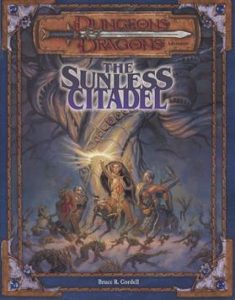 And while we’re at The Sunless Citadel, we’re going to loop back to 5e adventure design. This adventure was the first offering for D&D Third Edition. I’m not certain if people have the same nostalgic feeling for this (or Forge of Fury, the second in the line and in the book) as they did for Ravenloft, which begat Curse of Strahd, or this book’s Tomb of Horrors. But regardless, it seems to be a strange thing to include in this collection.
And while we’re at The Sunless Citadel, we’re going to loop back to 5e adventure design. This adventure was the first offering for D&D Third Edition. I’m not certain if people have the same nostalgic feeling for this (or Forge of Fury, the second in the line and in the book) as they did for Ravenloft, which begat Curse of Strahd, or this book’s Tomb of Horrors. But regardless, it seems to be a strange thing to include in this collection.
Take the first real area the adventurers access, the crumbled courtyard of the fortress. The floor of the courtyard is roughly twenty-five feet across to the entrance, but the floor is positively choked with rubble that slows movement. Why does it slow movement? No external threat exists: no time constraint to counter, no enemy able to spot the heroes the longer they stay out in the open. Just a series of DC 10 Acrobatics checks that stops movement if failed, or, if failed by five or more, prompts a 10% chance of a giant rat attack. “This encounter is why skill challenges were created,” writes a friend of mine. If you don’t fail any rolls badly enough, no rats to fight.
But that’s not all this area features. There’s a trap door that’s ten feet wide by ten feet long that drops people into a pit ten feet deep, which was triggered yesterday. Presumably, when the pit trap was triggered yesterday and the floor hinged downward, dumping the luckless goblin whose corpse is now below, all the rocks and debris and rubble also were dumped here. So when the heroes encounter this area, wouldn’t they see right in the center of this field of rubble a clear 10’x10′ square? Or are all the rocks magically glued to the pit trap cover, which is triggered by weight?
And the trap is only ten feet deep with the door hinged on one side, so all one really has to do is hop up when the door resets itself a minute later to climb out, assuming the door isn’t jammed into place with all of the rock that fell in, too.
Puzzled by the logic of this encounter — the first actual place in this adventure where things happen — I flipped ahead to a random room description in The Sunless Citadel, coming across a reference to make a DC 20 Wisdom (Perception) check. And then I glanced at the other area descriptions on the spread. They all call for Wisdom (Perception) checks. Flip to the previous page. “With a successful DC 15 Wisdom (Perception) check…” Flip forward. “With a successful DC 15 Wisdom (Perception) check…” “A successful DC 15 Wisdom (Perception) check made while searching…” Flip. “…separate DC 15 Wisdom (Perception) checks uncover…”
This is odd adventure design.
While there are some Strength checks, some Intelligence (Investigation) checks, and some Dexterity checks (and some Dexterity skill checks) in the adventure, it looks like the majority of things a character in Fifth Edition will do that’s not fighting is… perceiving. Just thumbing through the numbered encounter areas for the fortress level, there are twenty-one Wisdom (Perception) checks with the next most-numerous check to be made are either the seven basic Dexterity checks to unlock things with lockpicks or, if we’re looking at the skill list, the four Intelligence (Investigation) checks which are mostly made immediately after succeeding on a Perception check.
Again. Strange adventure design.
But there are elements baked into The Sunless Citadel for role-playing scenes, which is cool. It’s not all fights and Perception checks.
Forge of Fury is a better adventure (actually ranked #12 of D&D adventures of all time by gaming industry professionals in Dungeon magazine’s November 2004 issue). Christopher Perkins wrote, “To survive this adventure, the heroes must function as a team. The foes are smart and use their lairs creatively, and the black dragon at the end shows you don’t need a 20-foot wingspan to send adventurers screaming for their lives.”
The Hidden Shrine of Tamoachan is a mostly-linear trek through a Mayan/Aztec-flavored dungeon with a bit of an Indiana Jones-like trap-filled tomb feel. Like Tomb of Horrors, this originally came with a booklet of player handouts.
 White Plume Mountain comes next (which I’ve always confused with Expedition to the Barrier Peaks), which is more of a less-lethal version of Tomb of Horrors. It’s a small dungeon with rooms that are crazy fun. Clark Peterson in that Dungeon magazine article says, “A battle against a giant crab in a dome at the floor of a volcanic lake? Check. Reverse gravity water tubes with kayaking bad guys? Check. A completely frictionless surface, studded with pit traps? Check.”
White Plume Mountain comes next (which I’ve always confused with Expedition to the Barrier Peaks), which is more of a less-lethal version of Tomb of Horrors. It’s a small dungeon with rooms that are crazy fun. Clark Peterson in that Dungeon magazine article says, “A battle against a giant crab in a dome at the floor of a volcanic lake? Check. Reverse gravity water tubes with kayaking bad guys? Check. A completely frictionless surface, studded with pit traps? Check.”
But then we get to Dead in Thay, which should be the closest thing to adventure design for Fifth Edition. This adventure was created for D&D Next, the playtest verison of what would eventually become the current edition of the game. It’s a gigantic adventure that’s a massive dungeon crawl, with the dungeon split up into different zones, presumably one zone for each week of the D&D Encounters organized play program. But like Tomb of Horrors, this was “a tribute to killer dungeons from the game’s history”.
So of the seven adventures published here, four are in the mold of the killer dungeon: Tomb of Horrors, Dead in Thay, The Hidden Shrine of Tamoachan, and White Plume Mountain.
The last we haven’t mentioned yet is Against the Giants, the bit of nostalgia that lies in wait to entrap me.
I remember running this back in the days of Advanced Dungeons & Dragons and loved it. It had direct ties into the drow series (Descent into the Depths of the Earth, Shrine of the Kuo-Toa, Vault of the Drow) and the Queen of the Demonweb Pits. Previously adapted for Fourth Edition, the maps have reverted back to approximations of the originals. (Fourth Edition needed large areas for combats due to the design of that system. Even the hallways and rooms of Hill, Frost, and Fire Giants weren’t nearly ludicrously large enough to handle combats in that edition!)
Rather than just have the adventure be the first of the three giants adventures, WotC counts all three of these as one large Against the Giants adventure. (The three adventures were repackaged as one huge module in the AD&D era.) The adventure’s start is nebulous here — I can’t recall if the originals had things happen before the heroes attack the steading of the hill giant chief or not — your heroes are “given the charge to punish the miscreant giants” being told that they can keep all the loot they find. Now, let’s ignore that the map of the timber fortress of the hill giants appears to be structurally unsound, or that the icy and rocky caves of the frost and fire giants just happen to end in a rectangular shape that fills a letter-sized piece of paper. I’m looking at this with fond memories. But in the back of my mind, I’m wondering about Storm King’s Thunder.
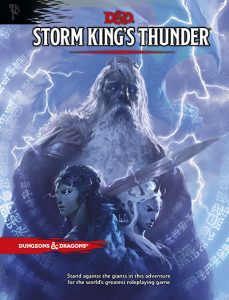 As we’ve covered last year, Storm King’s Thunder is more of a Fifth Edition riff on Against the Giants. While Storm King’s Thunder and this have interesting locales for the antagonists and interesting ways to deal with them, Against the Giants‘ setting seems more of a dungeon crawl; Storm King’s Thunder feels more like elements that would naturally occur in the fantasy setting of Dungeons & Dragons.
As we’ve covered last year, Storm King’s Thunder is more of a Fifth Edition riff on Against the Giants. While Storm King’s Thunder and this have interesting locales for the antagonists and interesting ways to deal with them, Against the Giants‘ setting seems more of a dungeon crawl; Storm King’s Thunder feels more like elements that would naturally occur in the fantasy setting of Dungeons & Dragons.
When I look back at Tales from the Yawning Portal, I realize I’m interested in Against the Giants because of that nostalgia feeling. I want to play this again. That’s exactly what this book is about. It’s not a good book for someone new to D&D, someone that has only experienced 5e. They would look at these adventures and walk away, confused. It’s not for them.
It’s a book for the older players.
It’s a book for the ones that came in during Third Edition with The Sunless Citadel and The Forge of Fury. The ones from the days of Advanced D&D with Against the Giants and Tomb of Horrors. The ones from the early days of D&D with White Plume Mountain and The Hidden Shrine of Tamoachan.
It’s not a good book for someone looking to run 5e games. But it is a good book for seeing how the games you played in your early days of roleplaying would work with the contemporary ruleset.
So what is this book?
The book is a collection of classic Dungeons & Dragons adventures updated for Fifth Edition, arranged so one could relive adventures from one’s gaming youth; a book of nostalgia, bringing adventure modules from earlier editions of Dungeons & Dragons into the current ruleset. And that’s good enough for me.
Addendum: I just received a copy of Curse of Strahd, which has a map of the area (and several locations) bundled in the back like a fold-out poster. I don’t see why they didn’t do something similar here, with perhaps the player’s map of the Doomvault on one side and the other side, in each folded section, maps for the DM for the different adventures. It would make referencing the adventure locations so much easier. For that matter, why not a pdf map packet for download at Wizards.com?
Tales from the Yawning Portal is available today at major book retailers for $49.95. You can also find online gaming versions of Tales from the Yawning Portal at Fantasy Grounds, Steam, and Roll20.
A copy of Tales from the Yawning Portal was provided by Wizards of the Coast free for review.
In the comments! What classic D&D adventures would you have chosen for an update to Fifth Edition?
With the tremendous success of Critical Role, Geek & Sundry and Nerdist are launching another roleplaying show on the Alpha streaming service. CelebriD&D will feature a regular crew of Marisha Ray, Taliesin Jaffe, Jessica Chobot, Dan Casey, and Matthew Mercer (as Dungeon Master, of course), supplemented each show by an additional guest player—Joe Manganiello in the first episode.
This series looks to be more condensed than Critical Role, and edited—perhaps along the lines of Harmon Quest (on the SeeSo service) but less comedic.
To see the first episode, you will need an Alpha account. However, there is a free 30-day trial available, and a short 7-minute teaser below.
- Comments Off on CelebriD&D Show Coming to Alpha
Trending
- Massdrop.com
- Oh the Irony—Illuminati Card Game Continues to Inspire Conspiracy Theorists
- Footprints, an Educational Ecology Game
- Home
- USPS Adds Board Game Flat Rate Box
- Baila, the Estonian Drinking Card Game
- Crystal Caste Wins Dice Patent Suit Against Hasbro
- Mirror Game, Red and Blue
- Are Board Games Dangerous?
- Board Games Based on Hindu Mythology
Archives
Most Popular Articles
- Oh the Irony—Illuminati Card Game Continues to Inspire Conspiracy Theorists
- The 20 Most Valuable Vintage Board Games
- The Truth About Dominoes On Sunday in Alabama
- Sequence Game, and Variants
- USPS Adds Board Game Flat Rate Box
- Baila, the Estonian Drinking Card Game
- The 13 Most Popular Dice Games
- Are Board Games Dangerous?
- Guess Who? The Naked Version
- What Happened to the Jewel Royale Chess Set?
Recent Posts
- Toy Fair 2019—Breaking Games
- Talisman Kingdom Hearts Edition
- Toy Fair 2019—Winning Moves
- Toy Fair 2019—Games Workshop
- Toy Fair 2019—Star Wars Lightsaber Academy
- Toy Fair 2019—Stranger Things Games
- Toy Fair 2019—HABA
- Licensing Roundup
- Game Bandit
- 2018 A Difficult Year For Hasbro But Not For D&D Or MtG
Recent Comments
- on Toy Fair 2019—Winning Moves
- on Game Bandit
- on Second Look—Dungeons & Dragons Waterdeep Dragon Heist
- on Crowdfunding Highlights
- on Beyblade SlingShock
- on Game Bandit
- on Game Bandit
- on Watch This Game!, the Board Game Review Board Game
- on Second Look—Vampire: The Masquerade 5th Edition
- on Palladium Books Loses Robotech IP License, Cancels Five-Year-Overdue Robotech RPG Tactics Kickstarter



